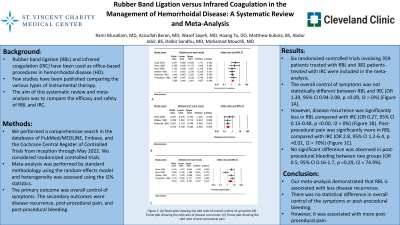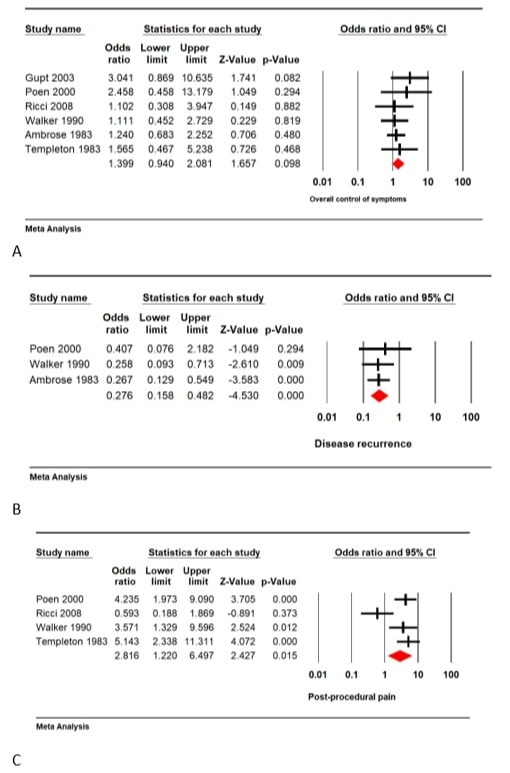Back


Poster Session A - Sunday Afternoon
Category: General Endoscopy
A0268 - Rubber Band Ligation versus Infrared Coagulation in the Management of Hemorrhoidal Disease: A Systematic Review and Meta-Analysis
Sunday, October 23, 2022
5:00 PM – 7:00 PM ET
Location: Crown Ballroom

Has Audio

Rami Musallam, MD
St. Vincent Charity Medical Center
Cleveland, OH
Presenting Author(s)
Award: Presidential Poster Award
Rami Musallam, MD1, Azizullah Beran, MD2, Wasef Sayeh, MD2, Hoang Ta, DO3, Matthew Kubina, BS4, Abdur Jabir, BS4, Dalbir Sandhu, MD5, Mohamad Mouchli, MD5
1St. Vincent Charity Medical Center, Cleveland, OH; 2University of Toledo, Toledo, OH; 3Cleveland Clinic Akron General, Akron, OH; 4Northeast Ohio Medical University, Rootstown, OH; 5Cleveland Clinic Foundation, Cleveland, OH
Introduction: Rubber band ligation (RBL) and infrared coagulation (IRC) have been used as office-based procedures in hemorrhoidal disease (HD). Few studies have been published comparing the various types of instrumental therapy. The aim of this systematic review and meta-analysis was to compare the efficacy and safety of RBL and IRC.
Methods: We conducted a systemic review and meta-analysis on the studies that compared RBL and IRC. We performed a comprehensive search in the databases of PubMed/MEDLINE, Embase, and the Cochrane Central Register of Controlled Trials from inception through May, 2022. We considered randomized controlled trials. From each study, we collected the number of patients who were treated with RBL and the number of patients IRC. The primary outcome was overall control of symptoms. The secondary outcomes were disease recurrence, post-procedural pain, and post-procedural bleeding. The random-effects model was used to calculate the odds ratios (OR), mean differences (MD), and confidence intervals (CI). A p-value < 0.05 was considered statistically significant. Heterogeneity was assessed using the Higgins I2 index.
Results: Six randomized controlled trials involving 359 patients treated with RBL and 381 patients treated with IRC were included in the meta-analysis. The overall control of symptoms was not statistically different between RBL and IRC (OR 1.39, 95% CI 0.94-2.08, p =0.09, I2 = 0%) (Figure 1A). However, disease recurrence was significantly less in RBL compared with IRC (OR 0.27, 95% CI 0.15-0.48, p =0.00, I2 = 0%) (Figure 1B). Post-procedural pain was significantly more in RBL compared with IRC (OR 2.8, 95% CI 1.2-6.4, p =0.01, I2 = 70%) (Figure 1C). No significant difference was observed in post-procedural bleeding between two groups (OR 0.5, 95% CI 0.16-1.7, p =0.29, I2 = 74.9%).
Discussion: Our meta-analysis demonstrated that RBL is associated with less disease recurrence. There was no statistical difference in overall control of the symptoms or post-procedural bleeding. However, it was associated with more post-procedural pain. Further randomized controlled trials are needed to confirm our findings.

Disclosures:
Rami Musallam, MD1, Azizullah Beran, MD2, Wasef Sayeh, MD2, Hoang Ta, DO3, Matthew Kubina, BS4, Abdur Jabir, BS4, Dalbir Sandhu, MD5, Mohamad Mouchli, MD5. A0268 - Rubber Band Ligation versus Infrared Coagulation in the Management of Hemorrhoidal Disease: A Systematic Review and Meta-Analysis, ACG 2022 Annual Scientific Meeting Abstracts. Charlotte, NC: American College of Gastroenterology.
Rami Musallam, MD1, Azizullah Beran, MD2, Wasef Sayeh, MD2, Hoang Ta, DO3, Matthew Kubina, BS4, Abdur Jabir, BS4, Dalbir Sandhu, MD5, Mohamad Mouchli, MD5
1St. Vincent Charity Medical Center, Cleveland, OH; 2University of Toledo, Toledo, OH; 3Cleveland Clinic Akron General, Akron, OH; 4Northeast Ohio Medical University, Rootstown, OH; 5Cleveland Clinic Foundation, Cleveland, OH
Introduction: Rubber band ligation (RBL) and infrared coagulation (IRC) have been used as office-based procedures in hemorrhoidal disease (HD). Few studies have been published comparing the various types of instrumental therapy. The aim of this systematic review and meta-analysis was to compare the efficacy and safety of RBL and IRC.
Methods: We conducted a systemic review and meta-analysis on the studies that compared RBL and IRC. We performed a comprehensive search in the databases of PubMed/MEDLINE, Embase, and the Cochrane Central Register of Controlled Trials from inception through May, 2022. We considered randomized controlled trials. From each study, we collected the number of patients who were treated with RBL and the number of patients IRC. The primary outcome was overall control of symptoms. The secondary outcomes were disease recurrence, post-procedural pain, and post-procedural bleeding. The random-effects model was used to calculate the odds ratios (OR), mean differences (MD), and confidence intervals (CI). A p-value < 0.05 was considered statistically significant. Heterogeneity was assessed using the Higgins I2 index.
Results: Six randomized controlled trials involving 359 patients treated with RBL and 381 patients treated with IRC were included in the meta-analysis. The overall control of symptoms was not statistically different between RBL and IRC (OR 1.39, 95% CI 0.94-2.08, p =0.09, I2 = 0%) (Figure 1A). However, disease recurrence was significantly less in RBL compared with IRC (OR 0.27, 95% CI 0.15-0.48, p =0.00, I2 = 0%) (Figure 1B). Post-procedural pain was significantly more in RBL compared with IRC (OR 2.8, 95% CI 1.2-6.4, p =0.01, I2 = 70%) (Figure 1C). No significant difference was observed in post-procedural bleeding between two groups (OR 0.5, 95% CI 0.16-1.7, p =0.29, I2 = 74.9%).
Discussion: Our meta-analysis demonstrated that RBL is associated with less disease recurrence. There was no statistical difference in overall control of the symptoms or post-procedural bleeding. However, it was associated with more post-procedural pain. Further randomized controlled trials are needed to confirm our findings.

Figure: Figure 1: Forest plots showing the odds ratio of: (A) Overall control of symptoms, (B) Disease recurrence, (C) Post-procedural pain
Disclosures:
Rami Musallam indicated no relevant financial relationships.
Azizullah Beran indicated no relevant financial relationships.
Wasef Sayeh indicated no relevant financial relationships.
Hoang Ta indicated no relevant financial relationships.
Matthew Kubina indicated no relevant financial relationships.
Abdur Jabir indicated no relevant financial relationships.
Dalbir Sandhu indicated no relevant financial relationships.
Mohamad Mouchli indicated no relevant financial relationships.
Rami Musallam, MD1, Azizullah Beran, MD2, Wasef Sayeh, MD2, Hoang Ta, DO3, Matthew Kubina, BS4, Abdur Jabir, BS4, Dalbir Sandhu, MD5, Mohamad Mouchli, MD5. A0268 - Rubber Band Ligation versus Infrared Coagulation in the Management of Hemorrhoidal Disease: A Systematic Review and Meta-Analysis, ACG 2022 Annual Scientific Meeting Abstracts. Charlotte, NC: American College of Gastroenterology.

